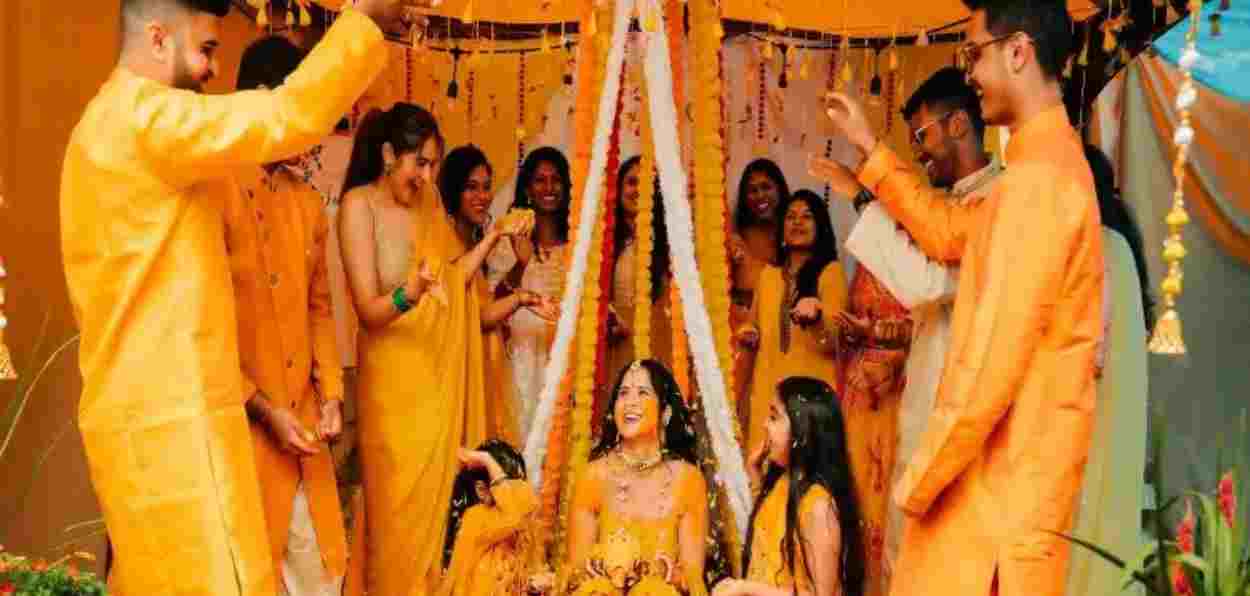
Ghaus Sewani, New Delhi
Marriage is an important sacrament in human societies and which has gained importance. The wedding customs are different in different societies around the world and these are not necessarily related to religion. In a multicultural and multi-faith society country like India, wedding celebrations are beside religion and seek to connect various religious communities like the Hindus and Muslims.
Ancient Hindu scriptures Rigveda and Atharvaveda consider marriage as the foundation of Grahasta Ashram – a phase of Hindu life where a man or a woman marries and raise a family. On the other hand, marriage is also ordered in the Quran and Prophetic Hadiths. According to Hindu traditions, 21 generations of human beings are freed of sins through a marriage ceremony. Even in Islam, marriage is said to be a cover from sins.
The method of wedding rituals may be different among the Hindus than the Muslims – the two largest religious communities of India - but there is synchronization in the customs and traditions that to into the celebrations and merry-making around a wedding. The common customs demonstrate the unity of the people of India and how they are influenced by each other.
Wedding ceremonies begin with religious ceremonies. For example, Hindus perform puja and Muslims perform Milad or Quran recitation. These rituals are meant to seek blessings from the divine on the couple who are entering into a crucial phase of their lives. A bridegroom in north India often wears a Sherwani doesn’t matter if he is a Hindu or a Muslim while the bride in the fashionable red lehnga-choli or a Sari.
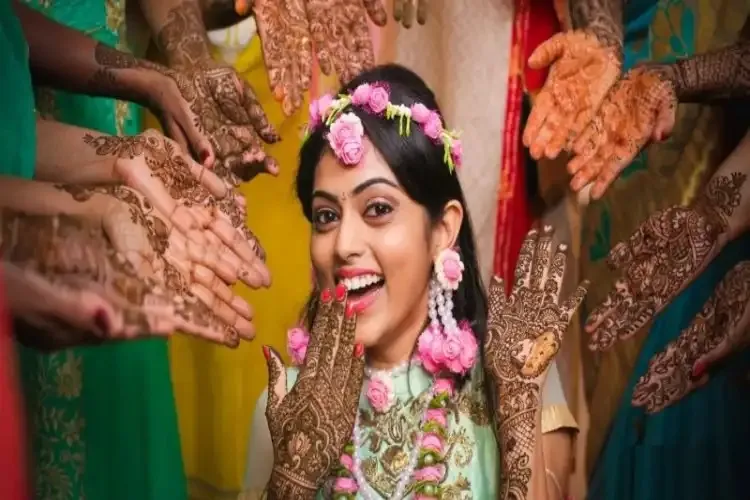
Bride and her Friends and relatives showing off their hena-dyed hands
The custom of tying the loose garments of the bride and groom in a knot as symbolic of their union is also common across cultures in India.
Hindu and Muslim bridegrooms in northern and eastern India cover their faces behind a sehra, a frilly curtain made of flowers and tied around their forehead. This is again only practiced in the Indian sub-continent and nowhere else in the Muslim world.
Similarly, a few days before the marriage, the girl is made to sit at home and she is made to do exercise and relax.
A Hindu wedding is solemnized by the bride and groom taking seven rounds of the sacred fire, the groom filling the hair parting of his bride with vermilion. Muslim wedding takes place with a Naulvi reading Nikah and both groom and bride signing the nikahnama (Contract of marriage) which is also signed by witnesses. However, in some areas of the country, a Muslim man applies vermilion in the parting of his wife’s hair after the nikah ceremony.
It is obvious that all these are not part of Islamic rules but are influenced by Indian society.
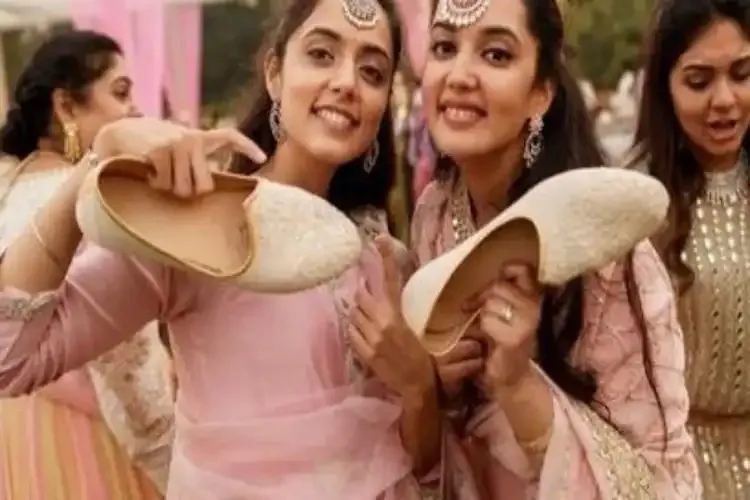
Young girls showing off the shoes of groom they have stolen
There is no mention of the ritual of engagement or betrothal in Islam, but it is practiced among Indian Muslims. Under this ritual, the bride and groom slip a ring to each other as a mark of their willingness to become husband and wife.
This practice is common among Hindus, Sikhs, and Christians.
Only after the betrothal, do the preparations for the wedding start. However, these days, under Western influence, the man and woman offer the ring to each other even before the betrothal, but the tradition is that they have to exchange rings in the presence of the family members.
Indian weddings also have a Haldi (turmeric) ritual. A few days before the wedding, women at the bride's house make a body pack consisting of herbs, oils, and cleansers like Fuller’s earth and turmeric. The ritual is also performed at the groom's house.
This paste cleanses the body and brightens the skin. This ritual is seen all over India and continues regardless of religion. A regular ceremony is organized for this and women wear yellow color on the day of the Haldi ceremony.
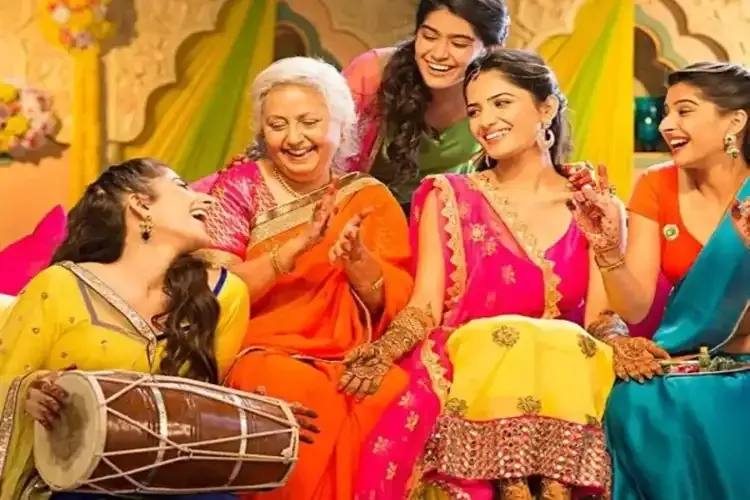
Women singing wedding songs
Just as the ritual of turmeric is a part of the wedding ceremony, so is the ritual of applying henna on the hands of the bride, groom, and all the guests in all Indian weddings. The Mehndi ceremony is usually held a day before the wedding. The womenfolk apply henna on their hands and feet.
The henna is considered a good omen, it also gives the red color to the hands and feet. In this ancient tradition, women get together and sing wedding songs and also dance. This is a warm-up to the wedding days and also helps spread cheers in the house where the wedding is taking place.
One of the reasons why henna is used in weddings is that henna balances body temperature. Due to this, the body of the bride and bridegroom remains calm and stress-free. Some old proverbs also say that the darker the color of henna, the in-laws and companions of the bride and groom are.
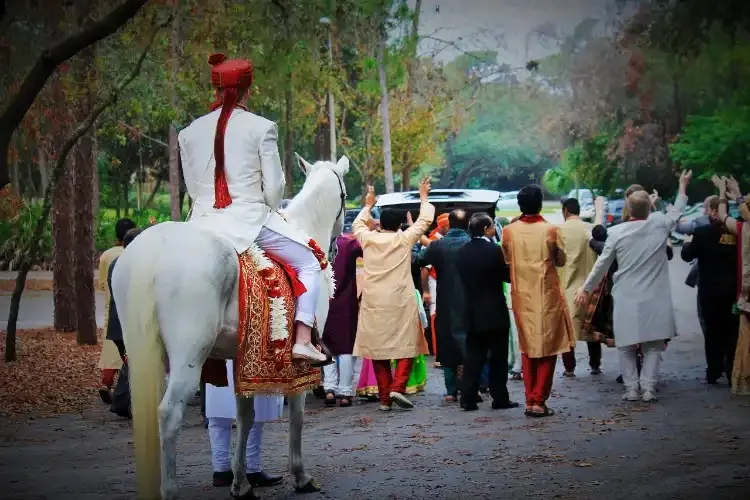
A groom on a horse on the way to the wedding venue
One of the most interesting wedding rituals is stealing of the groom’s show by the young girls related to the bride. A Bit of a fun game, the girls pounce on the shoe when the groom takes it off to proceed to his wedding venue.
The girls then hide the show and return it only instead of a hefty price. There is a lot of fun and frolic in this ritual, practiced both among the Hindus and Muslims. This ritual has been presented in some Bollywood movies with great beauty. Salman Khan and Madhuri Dixit starrer "Hum Aap Ke Hain Koon" have not forgotten the beautiful way in which this ritual has been presented by the audience.
ALSO READ: Assam Muslims celebrate weddings with a seasoning of Hindu traditions
The tradition of singing and singing at weddings in the subcontinent has been going on since ancient times. This is the custom in all religious marriages. These songs and songs are also an expression of Indian culture as folk songs are usually sung on occasions related to the bride and groom. In some areas, women also sing songs that contain abuse and these abuses are also part of the tradition. The songs are different in every region and language but the subjects of the songs are the same.
